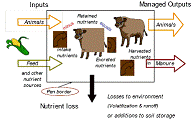Biological Systems Engineering, Department of

Department of Agricultural and Biological Systems Engineering: Presentations and White Papers
Date of this Version
September 2007
Document Type
Article
Abstract
Multiple assessments of ambient odor were made by trained individuals in the vicinity of a swine finishing operation in eastern Nebraska during the summers of 2005 and 2006. This paper addresses an analysis of assessor responses in Year 1 of this field study to determine what relationships existed between field odor measurements/ratings and ratings of annoyance potential, and to identify candidate measurement threshold values for odors that are likely to cause an annoyance. The first-year results showed that the likelihood of odor causing annoyance increased as ambient odors became more offensive, more intense, and more concentrated, with r2 values of 0.89, 0.81, and 0.64, respectively. Selection of threshold values for predicting annoyance depends on the extent of annoyance to be considered. In this analysis, candidate thresholds were sought to delineate both ‘any degree of stated annoyance’ and ‘consequential annoyance’ – defined as a state of odor that would likely invoke a change in behavior or activity level by the receptor and instill some memory of the odor event afterwards. Based upon the first-year results of this study, candidate thresholds for any stated annoyance and consequential annoyance, respectively, appear to be: 1 and 2 for intensity (on a 0-5 scale); 2 D/T and 7 D/T for odor concentration (as measured using a mask scentometer; and -1 and -2 for Hedonic tone (on a +4 to -4 scale). Further study is needed to verify these threshold values with other operations and animal species, as well as to clarify the relationship between odor intensity and concentration when measured in the field.


Comments
Paper presented at International Symposium on Air Quality and Waste Management for Agriculture. CD-Rom Proceedings of the 16-19 September 2007 Conference (Broomfield, Colorado). Publication date 16, September 2007. ASABE Publication Number 701P0907cd. Copyright © 2007 R. Stowell, C. Henry, R. Koelsch, and D. Schulte.